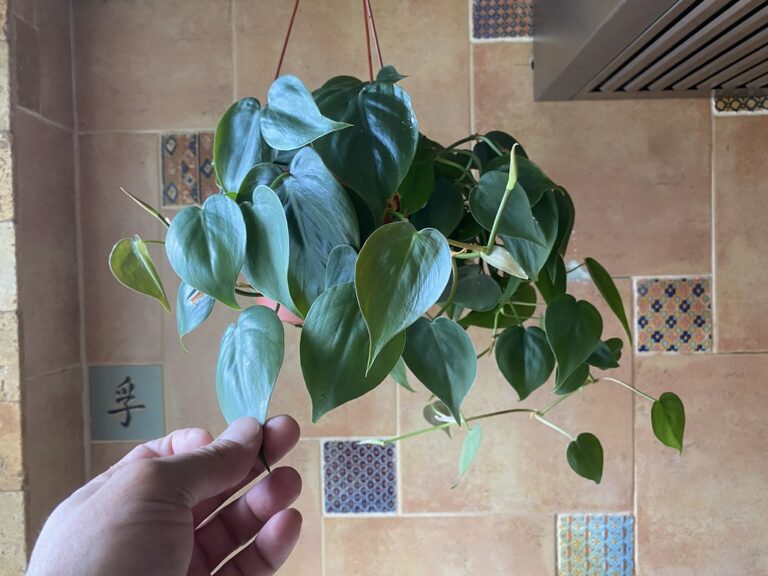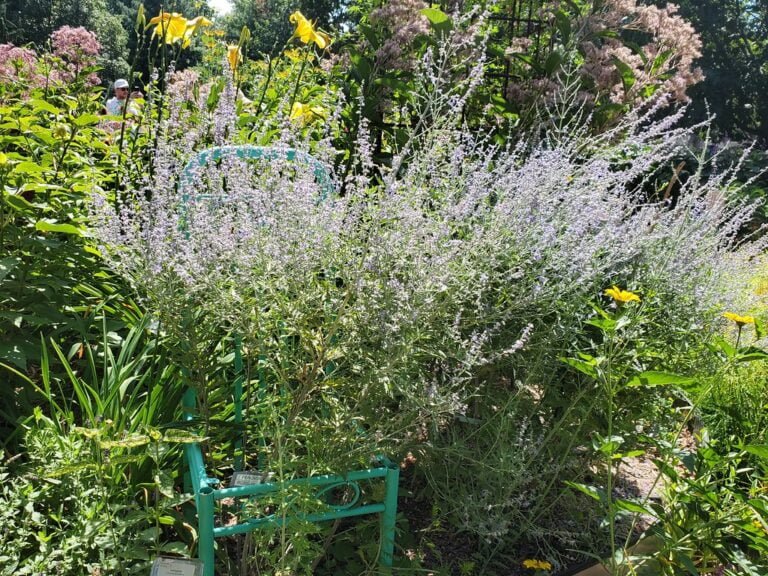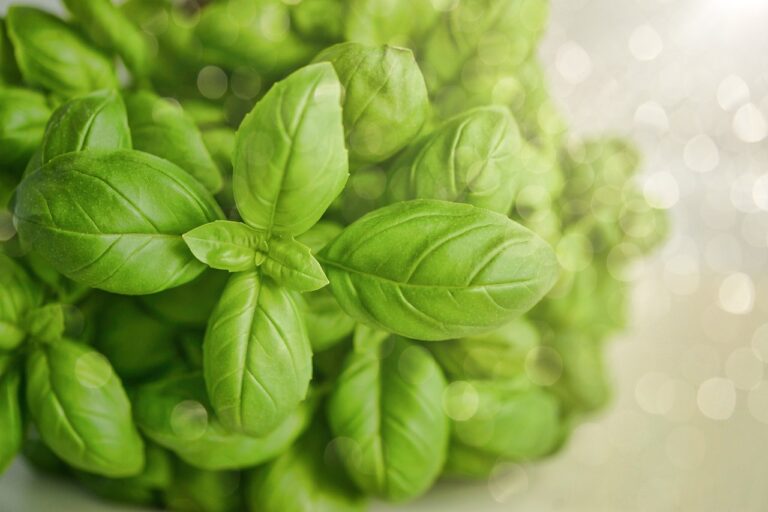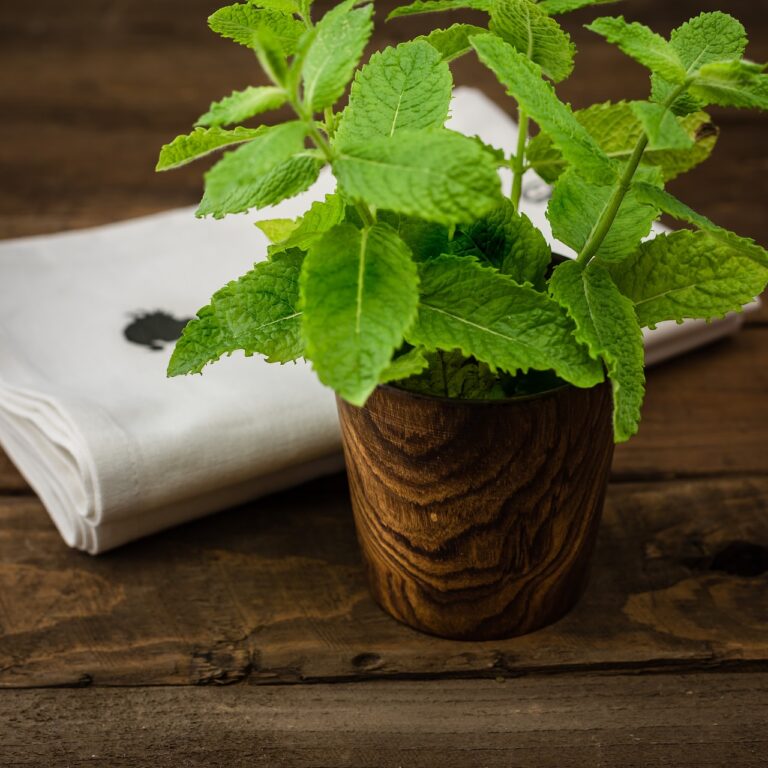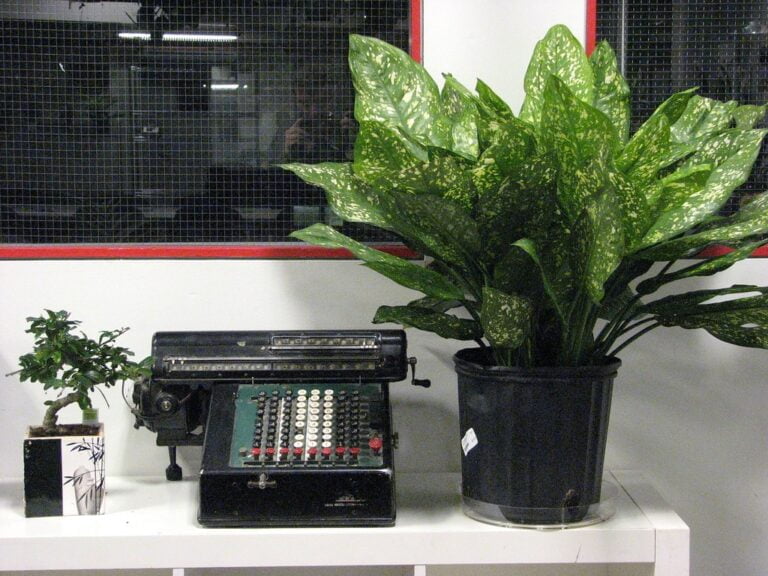Top Essential Herbs to Include in Your Garden
In my garden, I always include essential herbs like basil, mint, oregano, rosemary, thyme, and parsley. Basil needs sunlight and well-drained soil. Mint grows well in containers. Oregano and marjoram are rich in antioxidants. Rosemary is versatile and attracts pollinators. Thyme adds robust flavors and repels pests. Parsley, rich in vitamins, is easy to cultivate. Incorporating these herbs into your garden guarantees a variety of culinary uses and health benefits. Mastering these essentials establishes a strong foundation for herb gardening success.
Basil
Basil, with its various varieties and culinary versatility, stands as a foundational herb in any garden for both taste and usefulness. When planting basil, make sure it receives at least 6-8 hours of sunlight daily. This herb prefers well-drained soil with a pH level between 6 and 7. If planting in a container, confirm it has proper drainage holes to prevent waterlogging, which can cause root rot.
To grow basil successfully, sow the seeds directly into the soil after the last frost has passed. Alternatively, you can start with seedlings from a nursery for a critical head start. Space the plants about 12 inches apart to allow for adequate airflow and prevent diseases. Regular watering is essential, keeping the soil consistently moist but not waterlogged.
Harvesting basil correctly is essential for its continuous growth. Pinch off the leaves regularly to encourage bushier growth and prevent the plant from flowering too soon. When harvesting, pluck the leaves from the top, leaving the bottom leaves intact to confirm the plant’s survival and productivity. With its rich nutrient content and culinary applications, basil is not just a flavorful herb but also a valuable addition to any garden.
Mint
I’ve always found that growing mint can be both rewarding and challenging due to its vigorous nature. With various mint varieties like spearmint and pineapple mint available, it’s important to choose the one that suits your needs best. To contain its growth, consider planting mint in containers to prevent it from spreading uncontrollably in your garden.
Mint Varieties
Mint varieties, with their distinct flavors like peppermint, spearmint, and chocolate mint, are versatile herbs that thrive in moist soil and are best cultivated in containers to prevent their rapid spreading. Peppermint offers a invigorating, cooling flavor, while spearmint has a sweeter taste, and chocolate mint provides a hint of chocolate. Growing these varieties in containers helps restrict their growth and prevents them from overtaking your garden. By using well-draining soil and providing adequate sunlight, you can guarantee these mint varieties flourish. Whether used in teas, salads, or main dishes, the aromatic leaves of these mint varieties add a burst of flavor. Remember to trim them regularly to control their expansion and enjoy their culinary benefits.
Growing Tips
To ensure successful growth of mint in your garden, proper care and attention to its specific needs are crucial. Mint thrives in damp soil and is best cultivated in containers due to its spreading nature. Here are some practical tips for growing mint in your herb garden:
- Plant mint in a well-draining container to prevent waterlogging.
- Keep the soil consistently moist, watering regularly especially during dry spells.
- Trim mint frequently to prevent it from becoming invasive and to promote new growth.
- Harvest mint leaves regularly for culinary use or to make invigorating herbal tea.
- Consider planting mint near other plants to help repel pests in your garden.
Oregano/Marjoram
I’ll kick off the discussion on oregano and marjoram. These herbs, though closely related, offer distinct flavors – oregano boasts a robust, spicy taste, while marjoram leans towards the sweeter and milder side. Both are packed with antioxidants and known for their immune-boosting properties.
Health Benefits
Rich in antioxidants and essential vitamins, oregano and marjoram offer a myriad of health benefits that include boosting the immune system, reducing inflammation, and aiding in digestion. These herbs have anti-inflammatory properties that can help reduce inflammation in the body and are rich in essential nutrients like vitamin K, vitamin A, and iron. Traditionally used for their digestive benefits, oregano and marjoram can aid in digestion and soothe the stomach. Additionally, they are easy to grow and maintain, making them accessible sources of health benefits for everyday use.
- Boosts the immune system and protects against free radicals.
- Reduces inflammation in the body.
- Rich in essential vitamins and minerals.
- Aids in digestion and soothes the stomach.
- Easy to grow and maintain.
Culinary Uses
Oregano and marjoram are versatile herbs commonly used in Italian and Mediterranean cuisines for their robust, spicy flavor profiles. These herbs are crucial in dishes like pasta, pizza, meats, and salads, where they contribute a distinctive taste. To make the most of their flavor, harvest the leaves before they flower. Both oregano and marjoram thrive in sunny locations with well-drained soil, making them easy to cultivate in your garden. Their antioxidant properties and immune-boosting benefits add to their culinary appeal. Incorporating oregano and marjoram into your cooking not only enriches the taste of your dishes but also provides valuable health benefits. Experimenting with these herbs can take your Italian cuisine to new heights.
Rosemary
Rosemary, a versatile herb with a pine-like scent, is a woody perennial known for its myriad culinary and aromatic uses. As a hardy perennial herb, rosemary thrives in various climates and soil conditions, making it a popular choice for home gardens. Here are some key points about growing and utilizing rosemary:
- Culinary Delight: Rosemary is commonly used in dishes like poultry, meats, stews, and casseroles to add depth and flavor. Its aromatic oils infuse dishes with a delightful taste that complements a wide range of recipes.
- Adaptability: While rosemary is a woody perennial herb, it can be grown as an annual in colder regions. It adapts well to container gardening and can be brought indoors during winter to ensure a continuous harvest.
- Drought-Tolerant: This herb is known for its ability to withstand dry conditions, making it a low-maintenance addition to your garden. It requires minimal watering once established, making it ideal for busy gardeners.
- Aromatic Benefits: The fragrant, woody leaves of rosemary not only enrich the flavor of dishes but also offer aromatic benefits. The scent of rosemary is believed to improve memory and concentration, making it a valuable herb beyond the kitchen.
- Pollinator Attraction: Rosemary’s vibrant blooms attract bees, making it a pollinator-friendly plant. By adding rosemary to your garden, you can support bee populations while enjoying its culinary and aromatic qualities.
Thyme
Thyme, a versatile herb commonly featured in European, African, and Latin cuisines, offers a wide range of culinary and medicinal benefits. This herb plant, known for its robust flavors such as lemon and caraway, is a popular choice for seasoning savory dishes and marinades. Cultivating thyme is relatively simple as it is a perennial herb that can thrive both indoors and outdoors with minimal care requirements.
In addition to being a flavorful culinary herb, thyme boasts impressive medicinal properties. It is often utilized to deter pests in the garden due to its natural repellent qualities. Additionally, thyme is recognized for its ability to bolster the immune system, making it a valuable addition to any herb garden.
Symbolizing courage and strength, thyme is not only a culinary delight but also a powerhouse of antioxidants. These antioxidants not only boost the taste of various dishes but also contribute to the herb’s health benefits. By incorporating thyme into your garden, you can enjoy its culinary versatility and harness its medicinal properties for a healthier and more vibrant lifestyle.
Parsley
Parsley, a versatile and easy-to-grow herb commonly used to improve the flavor of soups, stews, and salads, is known for its abundance of Vitamin A and C, which support digestion and boost bone health.
- Parsley is a common and easy-to-grow herb used to liven up soups, stews, and salads.
- It is a good source of Vitamin A and C, aiding in digestion and improving bone health.
- Parsley is a biennial herb rich in antioxidants that enriches flavor in dishes and is often used as a garnish.
- This herb is grown as an annual in most regions, offering versatility in culinary applications.
- With mild onion-like flavor, parsley is rich in vitamins and minerals, making it a popular choice for improving dishes.
Parsley’s rich vitamin content makes it a valuable addition to herb gardens. Its ability to thrive in various conditions and its culinary versatility make it a must-have for any herb enthusiast. Whether used fresh or dried, parsley adds a burst of freshness to dishes. Its antioxidant properties not only contribute to its flavor-improving abilities but also provide health benefits. By incorporating parsley into your herb garden, you can easily enrich the nutritional value and taste profile of your culinary creations.

